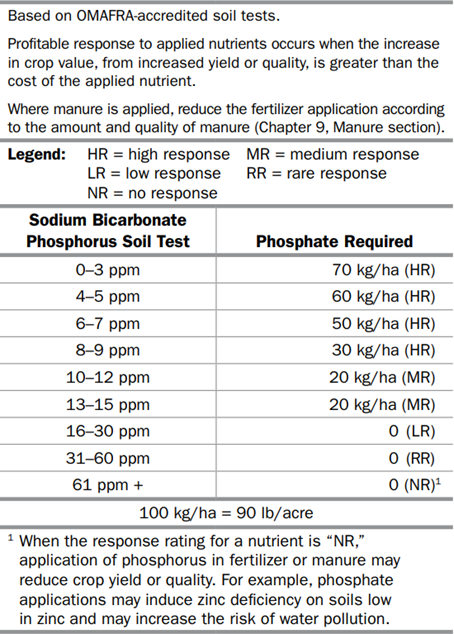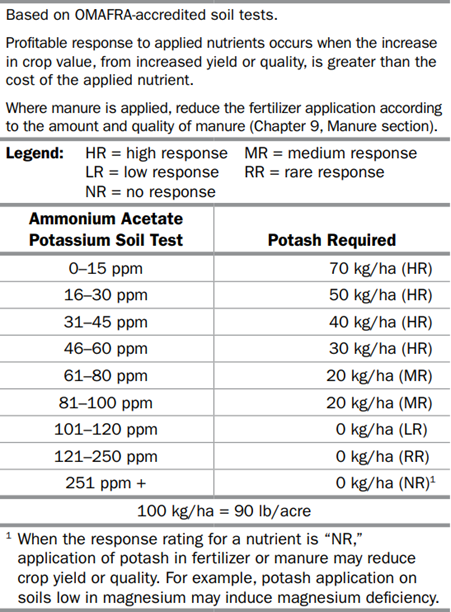Production Requirements
Soil Types: Prefers light to medium textured soils, but will grow in all soil types
Soil pH: 5.4–7.0
Preferred Rotational Crops: Corn, cereal crops
Should Not Rotate With: Soybeans, edible beans, canola or sunflower
Minimum Soil Temperature: 7°C
Optimum Air Temperature: 12°C–25°C
Earliest Planting Date: After the risk of frost has past
Required Growing Season: 70–90 days from planting to maturity
Buckwheat is a fast-growing summer annual with broad, heart-shaped leaves and white flowers. It takes approximately 5–6 weeks from planting to first flower and 10–12 weeks from planting to harvest. Buckwheat is frost sensitive and is usually planted later than other field crops.
Buckwheat is used for human consumption, as an ingredient in livestock feeds and as a source for buckwheat honey. It is also commonly used as a cover crop for weed suppression and green manure. The grain of buckwheat has an amino acid composition that includes lysine, and thus provides a more complete protein compared to other cereals.
The most lucrative market is the export of quality, large-seeded buckwheat to the Pacific Rim countries, particularly Japan.
Tillage Options and Seedbed Preparation
Buckwheat is often planted in organic rotations and in unseeded acreage conditions where planting of corn or soybeans has been delayed beyond expectations of reaching maturity in remaining growing season. Buckwheat is also commonly used in abandoned fields and old pastures, to rejuvenate the fields prior to planting other crops. When preparing the seedbed, aim for effective weed control, moisture conservation and a firm seedbed. Weed control options in buckwheat are limited, so it is important to address weed control as much as possible before the crop is planted. Field preparation, in either fall or spring, could include an application of glyphosate prior to tillage to improve perennial weed control, or alternatively, spring secondary tillage could remove remaining perennials and stimulate annual weed growth. Repeating shallow tillage approximately every 7–14 days until seeding time will help minimize new weeds and conserve moisture.
Field Selection
Buckwheat is well adapted to the wide range of Ontario weather conditions. It is susceptible to late-spring and early-fall frosts. Buckwheat is sensitive to high temperatures and hot, dry winds, especially if these conditions occur during flowering seed-set. Buckwheat will grow on a wide range of soil types and is likely to produce a better crop on poor soil than any other grain crop. However, buckwheat prefers well-drained soils and is intolerant of severely dry, saturated or compacted soils.
Avoid fields that contain very high residual nitrogen, as this can increase crop lodging. The lush growth associated with these fields has often led to a higher incidence of white mould. White mould is a problem in soybeans, dry edible beans, canola, sunflowers and buckwheat. If possible, avoid fields where white mould has been a problem and plan the rotation to avoid a sequence of these crops.
In order to reduce volunteer grain when growing buckwheat for seed, avoid planting in fields where other grains were previously grown. This problem can be overcome by tilling in the fall and planting a winter cover crop that is incorporated in the spring before planting the buckwheat.
Variety Selection
If the crop is being grown for export markets, variety selection becomes important. The Japanese, North American and European markets demand large-seeded varieties for milling and de-hulling purposes.
New varieties tend to have larger seed size, along with increased bushel weight. These large-seeded varieties have larger leaves and, as a result, do not require higher seeding rates compared to the smaller-seeded types.
For seed sources, see Cover Crop Seed Suppliers on the OMAFRA website at ontario.ca/crops.
Planting
Buckwheat will germinate at temperatures from 7°C–40.5°C and will flower 5–6 weeks after planting. Buckwheat has an indeterminate growth habit, so the crop does not mature uniformly. Yields are highest if buckwheat is planted immediately after the risk of frost has passed. Early planting into conditions that are favourable for crop emergence helps minimize volunteer problems the following year. Traditionally, buckwheat was planted in mid-summer and often harvested after frost. Although this method avoided flowering during hot weather, immature seeds would drop and reduce yields, and potentially pose a severe volunteer problem for following crops.
Planting with a drill will produce a more uniform stand, but satisfactory results can also be obtained with broadcast seeding. Plant seeds at a depth of 4–6 cm (1.5–2.5 in.) into moisture to obtain rapid and uniform emergence. Seedlings should emerge in 2–5 days.
Recommended seeding rates for grain production are 50–65 kg/ha (45–60 lb/acre). This will achieve the ideal plant stand of 140–183 plants/m2 (13–17 plants/ft²).
When planting buckwheat as a green manure or cover crop, the optimum seeding rate ranges from 50–60 kg/ha (45–54 lb/acre). Higher seeding rates result in higher plant populations, producing a smothering effect to aid weed control. However, even if the stand is thin, the plant’s ability to branch out will often compensate for thinner stands and will still result in good weed control.
As a Green Manure
Buckwheat can take up phosphate unavailable to other crops, thereby increasing the amount of phosphorus available to subsequent crops. To take advantage of its large biomass, incorporate or chemically control buckwheat between 4–7 weeks after planting, before the first seeds have set. If the field is left until full bloom, there is more likelihood of volunteer buckwheat problems the following year.
Fertility Management
Fertility requirements for buckwheat are similar to oats. Table 7–1, Nitrogen requirements for buckwheat, Table 7–2, Phosphate guidelines for buckwheat and fax and Table 7–3, Potash guidelines for buckwheat and fax display the suggested rates of nitrogen, phosphate and potash based on OMAFRA-accredited soil tests.
Table 7–1. Nitrogen requirements for buckwheat
| Growing Region | Maximum Rate of Nitrogen for Buckwheat |
| Southern Ontario | 35 kg/ha (30 lbs/ac) |
| Northern Ontario | 55 kg/ha (50 lbs/ac) |
Profitable response to applied nutrients occurs when the increase in crop value, from increased yield or quality, is greater than the cost of the applied nutrient.
Where manure is applied, reduce the fertilizer application according to the amount and quality of manure.
Table 7–2. Phosphate (P2O5) guidelines for buckwheat and flax

Table 7–3. Potash (K2O) Guidelines for buckwheat and flax

Harvest and Storage
Harvest
Buckwheat is an indeterminate plant. Flowers, green seed and mature seed are present on the plant at the same time. Flowering begins 5–6 weeks after sowing and continues for at least 1 month. Insects, honeybees and leafcutter bees are the main pollinating agents and are essential for good seed set. An arrangement with an apiarist will be of mutual benefit. Harvest must occur prior to the development of overripe seed. This will be approximately 10 weeks after planting, when the crop is still growing and flowering. At this stage, 70%–75% of the seeds should be brown, mature and not yet dropping from the bottom of the bloom spike. If harvest is delayed until the seeds nearest the ground begin to fall, yields will be decreased due to seed drop, and the volunteer population will cause problems for the next crop.
Yields will vary depending on pollination and weather conditions. Yields of 2.2 t/ha (40 bu/acre) are possible, but 1.1–1.6 t/ha (20–30 bu/acre) are more commonly reported.
Swathing
Swath the buckwheat ahead of harvest, if the crop has not been killed by frost. Do not desiccate buckwheat as desiccation weakens the stem and increases lodging. To minimize seed shatter, swath early in the morning when dew is present or in damp weather. Cut the buckwheat high, leaving stubble to facilitate drying.
Combining can occur when seed moisture reaches 16%. When combining, reduce the pick-up speed to match the ground speed to minimize shattering. The draper-type of pick-up causes less shattering than the drum-type. To minimize breakage, reduce the cylinder speed to one-third (600–800 rpm) of that used for cereal grains and set the concaves to approximately 13–16 cm (5.25–6.5 in.) in the front and 9 mm (0.38 in.) in the rear. The upper sieve is set at 16 mm (0.63 in.) and the lower sieve at 8 mm (0.3 in.). If seed is dehulling, increase the concave size or lower the cylinder speed. The lower sieve can then be opened gradually, to the setting that does not allow excess foreign material to pass through. Check that the wind blast is strong enough to remove the maximum amount of trash without blowing out clean grain.
Direct Combining
Direct combining is an option for late summer seeded crops that have been killed by frost. Wait 7–10 days after frost, keep ground speed low and cut stubble high to prevent overloading of the combine. To reduce breakage, pay attention to the amount of coarse material that is allowed to pass through so that only a minimum of seed enters the return.
Storage
Buckwheat can be safely stored at moisture levels under 16%. The longer buckwheat seed is stored the more oxidation that occurs resulting in the light green layer under the hull gradually changing to a reddishbrown colour. Oxidized seed is easily detected and becomes significant for markets that prefer freshly harvested buckwheat (i.e., Japanese market). Do not store or mix seed from previous stored crops.
Livestock Feed
Buckwheat grain can be used as a livestock feed in a limited inclusion basis in the ration. Buckwheat grain can be up to one-third of the grain concentrate portion for a beef or dairy ration. Swine feeding research, with newer varieties of buckwheat, found that the overall performance of growing-finishing pigs fed buckwheat in the ration was comparable to pigs fed cereal grains.
Feeding Precaution
Feeding buckwheat fodder, whether fresh or dried, can have toxic effects. The primary effect is a photosensitization in animals with light-coloured skin (this includes cattle, goats, sheep, swine and turkey) exposed to the sun. Jaundice is a secondary toxic effect.
Weed Control
Weed control in buckwheat can be difficult and requires planning, as there are few herbicides available, particularly for broadleaf weed control. Buckwheat is sensitive to residual herbicides (e.g., triazine, sulfonylurea and trifuralin). Since buckwheat is often sown late, there is ample opportunity to control problem weeds with herbicides or cultivation before seeding.
Insects and Diseases
Buckwheat seldom has insect or disease concerns other than white mould.